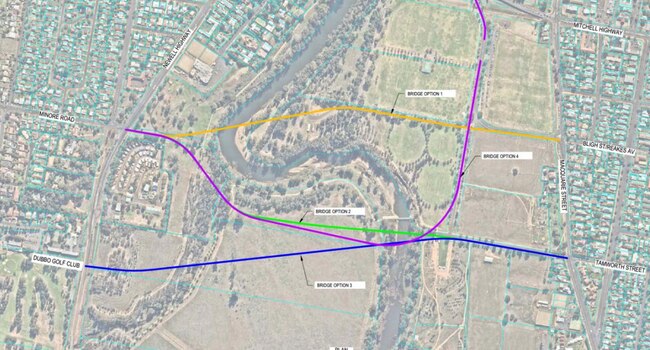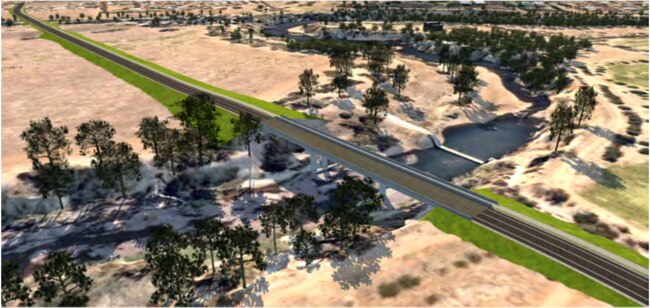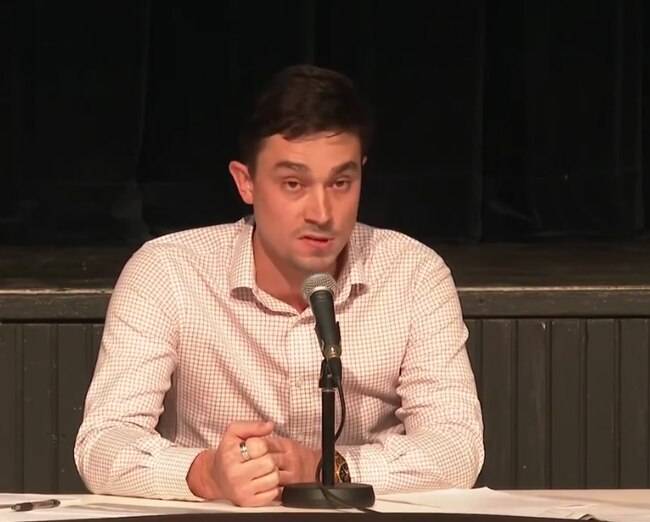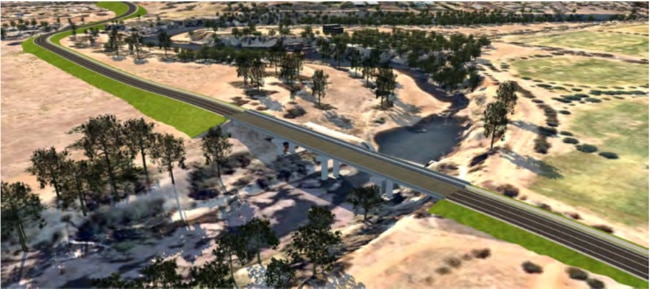South Dubbo Bridge: Business case reveals best locations
Experts have warned failure to build a new bridge linking west and south Dubbo could cost a staggering $7.8 billion with the number of houses in the region estimated to grow 197 per cent by 2050.
Dubbo News
Don't miss out on the headlines from Dubbo News. Followed categories will be added to My News.
Failure to build a bridge linking West and South Dubbo could cost the economy a whopping $7.6 billion over a 30-year-period, experts have warned.
The revelation was contained in a strategic business case report prepared by engineering and economic consulting firm Balmoral Group Autralia for Dubbo Regional Council.

Of the four proposed bridge routes put in the public domain for feedback, the report found two routes would deliver a net economic benefit.
A bridge connecting Whylandra Street, at the Dubbo Golf Club driveway, to the intersection of Macquarie and Tamworth streets, would cost an estimated $32 million to build and deliver a net benefit of $12 million over a 30-year-period, the report concluded.
The second route would deliver a $5.5 million benefit and cost an estimated $39 million to build would run from the intersection of Whylandra Street and Minore Road, to the intersection to the Macquarie and Tamworth streets.
The other two bridge options (options 1 and 4 listed above) examined were estimated to deliver no net economic benefits and instead deliver a net loss of about $5 million each.
“While the strategic business case indicates that these options are less likely to deliver net benefits, it cannot conclusively rule them out as not delivering value-for-money at this stage,” the report states.
“Without the South Dubbo Bridge, traffic from the south west district will be forced to use the LH Ford Bridge via the Whylandra Street and Victoria Street intersection, which is already close to capacity and even with stated upgrades, will experience a high degree of stress during peak hours by the mid 2030s.
“In order to accommodate future growth in West Dubbo, it is imperative that alternative river crossings to the LH Ford and Emile Serisier Bridge are developed and that demand for the Whylandra-Victoria Street intersection is managed. Failure to do so will likely constrain development in West Dubbo as new and existing residents of the neighbourhood lose the 10 minute city feel that makes Dubbo an attractive place to live and work.”

The report estimates by 2050 the number of houses in West Dubbo will increase by 197 per cent or about 6050, placing huge pressure on existing roads and “potentially increasing travel times over 10 minutes for some commuters”.
In a report to councillors, council’s infrastructure strategy and design manager Chris Godfrey repeated a warning issued in the Balmoral report about what it would cost if council did not invest in a new bridge.
“The issues identified … will continue unabated at a significant cost to the community, equating to $7.8 billion over a 30-year analysis period,” he said.

Capital costs were the main driver in differences between net positive or negative economic benefits estimates for each of the proposed bridge options, Mr Godfrey said.
“It should also be noted that while option 3 has the lowest overall project costs, it also accounts for the greatest area of land to be quarantined and purchased by council.
“The value of land acquisition is, as yet, unquantified …”
Feedback from the community about the four proposed bridge options was mixed, with sporting groups expressing concern about the impact any new bridge would have on fields around the Lady Cutler Oval precinct and environmental groups and residents raising concerns about the potential damage to Sandy Beach.
In a submission to the council, Dubbo Touch Association President Neil Webster said his club opposed all potential bridge options.
“Attracting large carnivals brings in millions of dollars each year to businesses in the region,” Mr Webster wrote.
“A busy bridge and road network would make the precinct less desirable and indeed prevent Dubbo Regional Council from tendering for future events as the precinct will no longer meet criteria expected to host state sporting events.”

Dubbo Rivercare Group has also opposed all four bridge options.
In response to concerns raised and the Balmoral report, Mr Godfrey has recommended council ditch the Sandy Beach bridge option completely and address concerns about safety, traffic, parking, noise and visual impacts on the sporting precinct before any final decision is made.
He also recommended any impacts on the existing Tracker Riley Cycleway be “fully mitigated” and “existing pathway connectivity be maintained”.
Councillors will decide on next steps when it meets on Monday.




